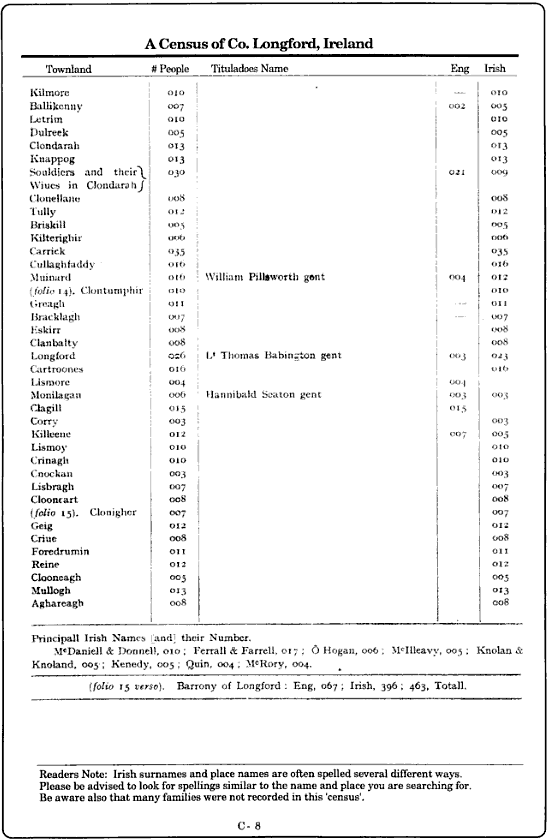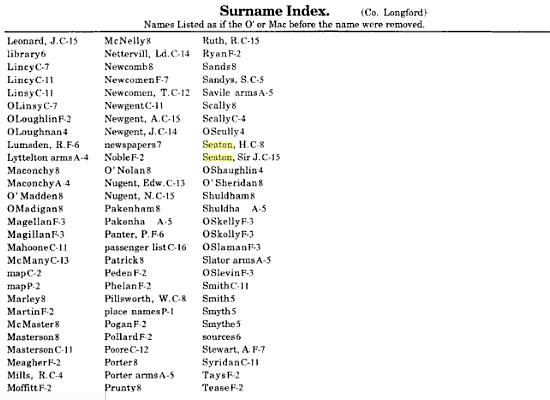 |
A History of Moneylagan
The lands of
Moneylagan are located in the parish of Clongesh (or Clonguish) within the Barony
and County of Longford in Ireland, which was once called Annaly,
and is approx. 1 mile south of the town Newtownforbes, and
having it's own village called Lowtown. They traditionally
belonged to the noble Irish family of the O'Farrells of Buoy,
Lords of Annaly, and the estate of Moneylagan, or Monilagan,
came to be acquired by Sir Robert Gordon of Lochinvar in the
reign of King James I, and was passed to the Seton's by
purchase, by Sir John Seton, 2nd of Barnes, in 1624.
Clongesh, called Clonguish or Cloongish, is a civil parish partly in the barony
and county of Longford and province of Leinster, Ireland, containing with the
post-town of Newtown-Forbes, which was formerly called Lisbrack. The parish is
situated on the road from Longford town to Carrick-on-Shannon, and on the rivers
Camlin and Shannon; it contains 9616 statute acres of which about 900 are
woodland, 6800 arable and pasture, and the remainder waste and bog. Limestone
quarries are worked for building and burning. A court for the manor of
Castle-Forbes is held occasionally: and petty sessions are held at
Newtown-Forbes every alternate Tuesday. The principal seats in the parish are
Castle-Forbes, the residence of the Earl of Granard; Brianstown, of Thomas
Gordon Auchmuty, Esq., representative of that Ilk, in Fife, North Britain;
Lismoy of the Rev. J. Mitchell ; Lisbrack cottage, of Verschoyle Crawford, Esq.;
Monalagan Cottage, of Dr. Forbes Crawford ; and Hermitage of T. H. Ellis, Esq.
The living is a rectory and vicarage, in the diocese of Ardagh, united to part
of the vicarage of Kiloe, and in the patronage of the Bishop: the tithes amount
to £461. 10s. 9d. The glebe-house was built in 1810, by aid of a gift of £100,
and a loan of £650, from the late Board of First Fruits: the glebe comprises 50
acres, and is contiguous to the church. The church, situated at Newtown-Forbes,
is supposed to have been originally built by the British settlers, about 1694 ;
it has been rebuilt by aid of a gift of £830 from the late Board of First Fruits
in 1829: There is also a church on St. Anne’s Hill in that part of Killoe parish
which is united with this parish.
The Roman Catholic parish is co-extensive with that of the Established Church:
the chapel is at Newtown-Forbes, where there is also a place of worship for
Methodists. At Lisnabo is a free school, founded and endowed by the Rev.
J. Mitchell of Lismoy, who has charged his estate with an annuity of £50 for its
support; the school house is an excellent slated building, with apartments for
the master and mistress, and cost £700. A school is aided by the rector and
diocesan fund, and there are four pay schools: in these about 600 children are
educated.
There are a few Danish raths, and the ruins of two churches. Part of the parish
is called Scot’s Quarter, a Scottish colony having settled here in the beginning
of the reign of Jas. I. The Castle Forbes here was besieged by the Irish troops
in the parliamentary war of 1641, and its defenders were obliged to capitulate
for want of supplies.
The
main revenue of the estate of Moneylagan, or Monilagan, was flax, used for fine
linen and which was worth 500 pounds Sterling a year, where the chief market was
eastwards in Leinster, at Drogheda. For the Scots families setting there in
Ireland, they were quick to establish themselves and to generate profitable
industry, as noticed in the History of County Longford:
"The
plantation of Scottish Protestant farmers in Northern Ireland, also had a great
influence on the production of flax. They were more industrious and quicker to
see an opportunity. The sons and grandsons of those Scottish planters began to
move further south during the seventeenth century and a substantial Protestant
community grew up in North Longford which was then called “Scots Quarter”.
Although the Irish climate was found to be very suitable for growing flax, our
short harvests were not favourable to ripening the flax seed, therefore no seed
or linseed products were produced. The crop was harvested for linen production
only while it was in full flower. In dryer climates linseed and linseed products
were used for a more widely varied number of products, such as animal meals,
oil, paint, varnish, French polish, soap, animal laxatives, oil cloth and
linoleum. Pectin was also extracted by boiling.
The growing season in Ireland was about one hundred days. If it was allowed to
grow any further, it would produce a poorer quality linen. The time of pulling
was very important for good quality fibre. For a very high quality product,
timing had to be correct to within three days. Once the flower appeared the hard
work began.
Having described flax-growing and linen production at national and international
level, I will now try to narrow down the story to County Longford and its
hinterland. County Longford is the fourth smallest county in Ireland in land
area (421 square miles), yet it was considered to have been the best
flax-producing county not alone in Ireland, but across the world. A very strong
statement from Robert Stephenson’s report on County Longford in 1760 bears this
out. It reads as follows:
From the great quantities of the most useful sort of yarn made in this county
and the industrious turn of its inhabitants, it may be speedily made to vie with
any district containing the same number of inhabitants on Earth, in the most
profitable and extensive branches of the linen manufacture, but to do this, the
numbers of weavers must be made, by some scheme and added to their present
stock."
Sir John Seton of
Barnes received a charter in 1628, noted in the
Calendar of the patent and close rolls of
chancery in Ireland: of the reign of King Charles I (1628), for the Seton Estate of MoneyLagan, or
Balleleghan (Babington), Longford, Ireland:
"Grant to Sir John Seton, his heirs
and assigns, for ever, as an undertaker, of 2,000 acres arable and pasture, and
1,104 acres bog and wood, in the barony and county of Longford ; a portion of
'which is to be held of the King in capite by knight's service, and the residue
of the Castle of Dublin, in free and common soccage. The lands are erected into
a manor, to be called the manor of Monelagan, otherwise Balleleghan, with power
to create tenures, and hold a court leet, court baron, a weekly market on every
Thursday at the town of Killeene, and two fairs at Monelagan, alias
Balleleghan, one on the 2oth April, and the other on the 20th October, with such
covenants, conditions, and provisoes as are contained in the patents of
undertakers of the territory of Ely O'Carroll.—Dublin. August 8,4°."
Sir
John Seton, 2nd of Barnes and also of Hailes, was
raised at Seton Palace, Winton and Pinkie House under the
tutelage of his uncles the Earl of Winton and the Earl of
Dunfermline and well travelled in France and Europe. He was bred to military service and to serve the Royal Household
and succeeded his father when he came of age, 3rd October 1615.
Using the benefits of his estate and his
father's pension's from his wise uncles' management and
assistance (Robert, Earl of Winton), was able to greatly expand his fortunes.
He is noted as a young man in the Funeral of Chancellor Seton in
1622, where he took his place in the retinue of the Seton
household. Under the tutelage of his
uncles, he rose to become a Gentleman of the Privy Chamber and
officer of the Court of King Charles I, and was a noted
companion of the Marquis of Montrose in 1646. With his
increasing wealth, he acquired the land in Ireland from Sir Robert
Gordon of Lochinvar, and added the estate and castle of Monylagan (Mionylangain,
Monilagan, Monalagan or Moneylagan), Clongesh Parish (Clonguish), in Co. Longford,
in 1628 (worth 500 pounds Sterling a year) and is occasionally referred to as Sir John Seaton of Mionylangain,
Longford.
 His eldest son,
Alexander, while travelling to the family estate in Ireland, met
and married a daughter of the noble Irish family of O'Ferrall (also
spelt Ophuall), of the family of Buoy, Lords of Annaly (where Longford was
once called Annaly), Ireland, and settled in Ireland.
Alexander was later accused of assisting the "Ferrells" in Ireland
in their struggles against the Crown and was imprisoned in Dublin, later transferred and imprisoned in the Edinburgh Tolbooth
in Scotland. Much to his father's dismay, and despite efforts of the
family to have him released, he predeceased his father
without heirs as a result of his imprisonment in
1642. Likewise, Sir John Seton's second son from his third marriage
died as a young man, and he was succeeded by his only surviving
son, Sir George Seton. His eldest son,
Alexander, while travelling to the family estate in Ireland, met
and married a daughter of the noble Irish family of O'Ferrall (also
spelt Ophuall), of the family of Buoy, Lords of Annaly (where Longford was
once called Annaly), Ireland, and settled in Ireland.
Alexander was later accused of assisting the "Ferrells" in Ireland
in their struggles against the Crown and was imprisoned in Dublin, later transferred and imprisoned in the Edinburgh Tolbooth
in Scotland. Much to his father's dismay, and despite efforts of the
family to have him released, he predeceased his father
without heirs as a result of his imprisonment in
1642. Likewise, Sir John Seton's second son from his third marriage
died as a young man, and he was succeeded by his only surviving
son, Sir George Seton.

Census of Co. Longford, Ireland,
1659.
Sir John Seton (Seaton) 4th of
Barnes, and of 3rd of Hailes (d. 03.1659), succeeded to the estate of his
father, but
died a relatively young man shortly afterwards in Edinburgh, and was
buried at his request, "with decency, but without pomp or great show",
and interred in the place of his father's burial at Seton Collegiate
Church. He was however twice married: his son George from his first
marriage succeeding him; and from his second marriage to Lady Margaret Hay (daughter of 9th Earl of Erroll
and sister to Lady Ann Hay who married George Seton, 3rd Earl of Winton), he
had son's: John
Seton who settled in Ireland and from whom descend the Seaton/Seeton's of
Nova Scotia; and Hannibal Seton who also had settled for a time on the
family estate in Ireland, before returning to Scotland and becoming a
Burgess of Haddington; as well as other issue noted in the
historical records of County Longford and surrounding areas in Ireland.
He and his wife, "Lady Seaton", are noted in the
papers of Sir Arthur Forbes, during the siege of Castle Forbes
in Longford, Ireland in 1641-42.
HISTORY OF THE
COUNTY LONGFORD
Under this state of things the following landed gentlemen of the
County of Longford and their families were dispossessed of their
estates, which were either sold to Cromwellian troopers or other
adventurers the hereditary owners having to transplant
themselves and their families beyond the Shannon immediately :
County of Longford, 1657
In 1657, Cromwell assumed the title of Protector and a
sovereignty over the three kingdoms, which so disgusted his
co-regicides that they withdrew from his army, and left him to
enjoy his glory alone ; and the same year he ordered one
Christopher Grough to make out a list of the " forfeiting"
Papist proprietors in each county in Ireland. This list embraces
the names of all those whose estates had been confiscated, but
from which they had not been driven, but were allowed to remain
in a state of dependency ; and in many cases, as if by the
intervention of a kind Providence, the officers of the
Commonwealth, as well as those who were to receive the lands,
either failed to claim them or were persuaded by some momentary
consideration not to disturb the old proprietors, and merely
held the deeds which subsequently made them landlords ;
otherwise there had been no native Irish left in Longford
County.
County of Longford, 1657
Barony of Shrule
Twenty confiscations ; no addresses given :
Nicholas Barne well, James Dillon, Edmond Ffarrell, Ffergus
Ffarrell, Francis Ffarrell, Grarrett Ffarrell, Thomas
Fitzgerald, James Ffarrell, John Ffarrell, Lisagh Ffarrell,
Richard Ffarrell, Teig Ffarrell, Thomas Fitzgerald,
Charles Fox, John Murtagh, John Murlogh, James Quinn, and Sir
John Seaton.
By order of the Governors of Ireland, a census of this
country was taken in the year 1659, when the population of the
County Longford was found to be laid out as follows :
In the barony of Longford there were 396 Irish and 67 English.
The gentlemen residing in the barony were : Sir Arthur Eorbes,
Castle-Forbes ; Alexander Aghmooty, Ballybrian ; William
Pillsworth Minard ; Lieutenant Thomas Babington, Longford
; and Hannibal Seaton, of Moneylagan.
The principal
Irish families were : MacDonnell, 10 people; Farrells, 17;
O'Hagans, 6; MacElvay, 5; Knowlan, 5; Quinn,
4 ; and MacKay, 4. The total population of Longford barony in
those days was 463 people, all told ; of these, 52 formed the
population of Longford borough.
Sir George Seton, 5th and
Last Baron of Barnes and 4th of Hailes and last Seton of Moneylagan, spent a
significant portion of his life travelling in Europe, and in
France in particular, using the benefits of his estate. He leased the lands
of Easter and Wester Barnes in Scotland via sasine in 1681, to George
Cockburn of Piltoune of the Ormiston family, and he and the Seton's of Garleton had
various continuing legal disputes
over their adjoining lands, and were long noted in court records in
Edinburgh, before the estates were finally sold.
Also noted in legal proceedings records
in Edinburgh, he pursued the Irish Estate of Moneylagan still held by his father, against Sir Arthur Forbes 1st Viscount Granard, in 1683
after Forbes seized the Seton Estate in Ireland and claimed it as his own.
He however evenually lost the lawsuit and the estate at tremendous financial
cost, noted as:
"Sir Arthur Forbes,
Viscount Granard, Lady
Margaret Hay, and the
Lady Bearford, gave in a
bill against George
Seton of Barns,
complaining he had
vitiated a principal
agreement, or decreet-arbitral,
passed betwixt his
father and him in 1658,
by making eighteen
hundred sixteen
hundred, and his
estate this
estate, and adding the
word rents, which
corrupted the sense...
Barns, in this process,
to blunt Lady Margaret
Hay his stepmother's
process, by the popish
priests, agreed with
her. Yet the enemies he
left behind prevailed
thus far, as we have
seen ; which they sought
to counterbalance and
enervate Barns's suit he
had commenced in
Ireland, for some lands
there belonging to his
father, where they made
use of the foresaid
decreet-arbitral as a
renunciation of all he had to crave, save the lands of Barns."
The old castle at Moneylagan is now
long gone, as are others remaining from the other castles on the
estate lands, and the only remaining is that of the Forbes'
demense at Newtownforbes.
|

